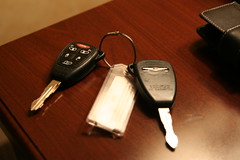 A couple of days ago I noticed a twitter post from Forrester Analyst Jeremiah Owyang that made it sound like he is considering switching to the Dvorak keyboard layout. I felt I was in a unique position to respond after having switched to Dvorak about 5 years ago.
A couple of days ago I noticed a twitter post from Forrester Analyst Jeremiah Owyang that made it sound like he is considering switching to the Dvorak keyboard layout. I felt I was in a unique position to respond after having switched to Dvorak about 5 years ago.
As usual, Wikipedia has a fine overview here if you are unfamiliar with Dvorak, but here’s the short version: back before the dawn of history, like the 70’s, there used to be these things called typewriters. If you are less than 25 you may have never even seen one, but the idea was that you had a keyboard and when you pushed a key, this little metal arm with a stamp of a letter on it would hit an ink-soaked ribbon and make that mark on a piece of paper (photo via Creative Commons on Flickr from Shel Israel).
Even if you have seen or used a typewriter you may not know that there is a reason behind the way the keys are laid out. The overall gist of these legends is that if you typed too fast these swinging metal arms would snag each other and jam the machine. To avoid this the keys were assembled in a formation to slow you down.
Dvorak applied some science and came up with an alternate layout that would allow you type as fast as humanly possible. Both Mac and PC support Dvorak (former Microsoft CTO Nathan Myhrvold is said to type in the 80 words per minute range, and his rank might explain why when you have Dvorak activated in Windows you can toggle back and forth between it and QWERTY (standard keyboard layout, named after the top left row of keys), using left CTRL and Shift keys.
Ok, so you’ve been brought up to speed. Here’s the meat – what you need to know if you consider switching:
- You’ll notice that it’s easier – Even when you start you’ll feel how much better it is having the most frequently used keys in the right spots. This is important in extending your typing lifespan. After 10 years of hammering on crummy laptop keyboards on a desk my hands, wrists and arms were often stiff or aching. I made a full switch to a Microsoft Natural Keyboard, a trackball (much less stress than a mouse) and Dvorak. Easier also translates to less pain if typing is your life, it will add years to it.
- Difficult to learn – There are two major problems here. First you are going to drop down under 25 words per minute for up to a month and it will take a long time to get up over 50 wpm. It took me over a year to get back up over 60 wpm, that’s a big productivity hit for a full year. The other problem is that you need to find a typing tutor software that works with the dvorak layout. Most typing tutor programs are designed to teach you row by row, and that is no longer valid when you change the layout.
- It’s Faster – With the same amount of work you will type faster once you get up to speed. The world record holders are on Dvorak. When you go back to a QWERTY keyboard you’ll realize how rotten the layout is. Overall I am about 5 wpm faster (You can test your typing speed here, feel free to share your scores). Speed is an interesting factor – if you are doing transcription this will put you in another league. On the other hand you may notice that you are not actually held up by your hands, but by your mind as you are putting together sentences (in technical writing for example). I know that although my mind is not nimble enough to change gears between layouts, I always have a problem with my thoughts coming faster than my hands or mouth can write or recite them.
- What you see is not what you get – Hardware is a big problem. You can either pay big bucks to get a Dvorak keyboard, or you bust out the Sharpie and write the new letters on them. If you are using someone else’s machine you are stuck. The only good news is that after you have made the transition you are rarely looking at the keyboard.
- Transition is hell – going from 65wpm down to half that is incredibly frustrating for the first month.
- Games and death of the holy trinity – Many games use an arrow formation like AWD for Left-Forward-Right. All these are ruined in Dvorak, but most games allow you to remap the keys. The same goes for the trinity – if you are a hardcore keyboard user you know the trinity – XCV, three keys that with the Control key are cut, copy and paste (being error prone, I add the fourth, Z, for undo). These keys are now spread apart, but there is an alternate dvorak layout that leaves them together just in case you are an uber freak who wants to use a bizarre, seldom used keyboard variation on top of a bizarre, seldom used keyboard layout.
- Not everyone can switch – This is another critical point, this has to do with your brain and motor skills. I’ve read of some who can touch type 60wpm on both layouts. I don’t know if this is true, but I cannot do this. From my limited research, most people can type one layout or the other, not both. If you have the capacity to do both, then there’s nothing holding you back, you should switch to Dvorak at once, if you are like me and have some real mental issues that will take you up to a year to get back up to speed you may not want to go this route.
- Security Bonus – Nobody else can type on your keyboard unless they know the secret Ctrl&Left-Shift code.
- You are one huge frackin’ geek – This makes you a card carrying member of the dork club. I always get the same weird look when I have to explain to people why my keyboard doesn’t type the letters on the keys. I think it’s the same look you’d get if you were in High School and you were talking to the Cheerleading Captain about the cool Dungeons and Dragons and video game festival you dressed up in costume for last weekend. Please let the record accurately reflect that I have never dressed in costume.
- Some keys get lost – If you have need for some of the more screwed up characters like the curly bracket or the pipe you will have a hard time finding them, I had a hard time with them on the standard layout anyway.
- Passwords can be tougher – Not getting any visual feeback and using strong passwords can be tough now and then, I’ve had to resort to using notepad to confirm I have them right and then pasting them over. No hunt and peck for accuracy when the keys have the wrong letters on them.
Who should switch? If you type more than 4 hours a day, or to the point that you are in pain, you will get a productivity boost and pain reduction in the long run.
Who should not switch? If you spend more than an hour a day on a shared machine it’s not worth it unless you are a brainiac that can shift gears between layouts. If typing is not a core competency for what you do, don’t bother.
In closing, the benefits are not as great as I had hoped, I would have liked 10 wpm. On the other hand, I understand you can switch back in less than a month, but I wouldn’t want to. Your keyboard sucks.
Further comments: After posting, I forgot – there is actually a relevant business and Marketing point here. Consultants use Dvorak as an example of human behavior, market power and human factors. Even though Dvorak is an obviously superior and more efficient way to lay out a keyboard because the standard has been set the world lives with the crummy layout. It’s a good case study for the “We do it this way because everyone else does” mindset that plagues every bureaucracy.

